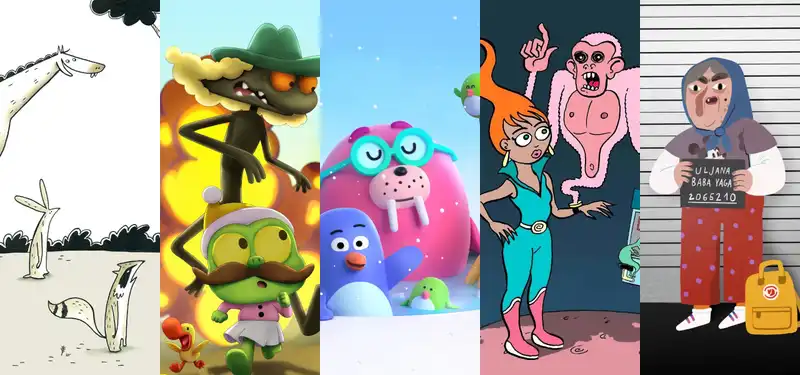Sep 26, 2023
Cartoon Forum 2023 Final Pitch Review of New European Series
After four days and 82 pitches, Cartoon Forum 2023 came to an end last week.
Many creators, writers, and artists had the opportunity to present their ideas for television programming to broadcasters, producers, and distributors.
In addition to the programs listed below, here are 10 other pitches from the event.
Country Ireland & Canada
Studio Sixteen South & Nelvana
Audience demographics: preschool
Episodes: 52 x 11 min
It is not easy to express the spirit of a show in a pitch, but “A Name for Steve The production team for “A Horse Named Steve” was able to express the show's freewheeling energy while essentially managing it. With one staff member quitting face down and another donning a full-body horse costume, the pitch allowed us to glimpse the show's bright 2D visuals and expressive characters.
Steve's journey takes place in the woods, where he attempts to assimilate into the forest and climb the social ladder. Extroverted and melodramatic, Steve encounters a variety of animals who encourage him and mess with him. A Horse Named Steve feels energetic and reasonable in achieving the heart and comedy it aims for.
Country France
Studio Folivari
Audience Age: 6-9 years old
Number of episodes: 52 x 13 minutes
Kiki & Iren's motto is “A big messy romp”. Kiki and Iren's protagonists are well-meaning tourists from another planet who are curious about the ways of Earth. They encounter everyday objects, such as an umbrella that thinks it makes it rain and a cow-like animal that they know has milk in it but don't know how to milk it. The show's sense of slapstick blends well with its 2D style, and some of the visuals draw clear inspiration from the Hana Barbera animated comedy.
Massive pranks are not all the show has to offer. A major theme of “Kiki & Iren” is acceptance. The protagonists learn to accept the human way of life, and the humans learn to accept visitors from other worlds. The aliens encounter people with different attitudes toward them and strive to understand what it means to be human.
Country France
Studio TeamTO
Audience It is rare to find a show for young children with a sense of humor as dry and almost ironic as What's Up Eesha. However, her Arctic friends are a bit obsessed with her and are drawn to any interesting activity she attempts to conduct for the sake of peace. Comedy arises from the creative ways in which Isha seeks evasion. In one instance, she needs peace and quiet while composing, but there is a crowd around her. Her only solution is to take a hot air balloon ride and finish the song above the clouds.
What's Up Eesha-'s simple art style allows the focus to be on the characters and their expressiveness, which is a big part of what makes the show work so well. However, that is not to say that it does not look good. There is something warm and endearing about the show's character models, which are squishy to the touch and mimic stop-motion; everything in What's Up Eesha- is made to be endearing, and the show is a good example of this.
Country Belgium
Studio Haptic
Audience demographics Young Adult
Episodes: 26 x 5 min
Pixie Pollux is about an intergalactic food truck owner who travels across the vast The vast beauty of the universe and the capitalist The combination of the vast beauty of space and the cynicism of capitalism is the epitome of the contrasting energies the show deals with; the 2D art style builds a character model that feels familiar and familiar to other animated sitcoms for adults, yet is far outside the box. For example, the main character, Pixie, travels with her pet, SPAC, a cat head attached to a human foot wearing high heels. Much of the show, including its depiction of outer space, is out of the ordinary.
Thanks to the show's setting, the creators are able to do some extremely bizarre things by mixing scientific concepts with ingenious inventions. For example, Pixie plans to use his vast fortune to retire in a white hole. The exact opposite of a black hole devouring light, it would essentially function as a cosmic heaven. The fact that one must be wealthy enough to live there is an interesting and original method of social critique.
Country Czech Republic & Germany
Studio Heliumfilm & Reynard Films
Audience demographic Young people
Episode: 10 x 20 min
In the experimental “Happily Never After” the mockumentary format is merged with animation. In this series, the documentarian documents the lives of fairy tale creatures in the present day. These creatures are relegated to the margins of society because of outdated ideals, and the show aims to look at how we treat people who do not conform to social norms.
The show's 2D models are placed on top of live-action backgrounds to emulate hand-held camera movements. Much of the show's comedy is also derived from the absurdity of its central characters. One episode features Baba Yaga, a mythical child-eating witch. After eating a TikToker who was live-streaming her own vile deeds, she is trapped and must testify in court. Each episode will feature a variety of fictional characters adapting to modern life. Whether it is a midget trying to break into Hollywood or an anxiety demon attacked by anxiety itself, “Happily Never After” achieves absurdity and social commentary at the same time.
.



Post your comment